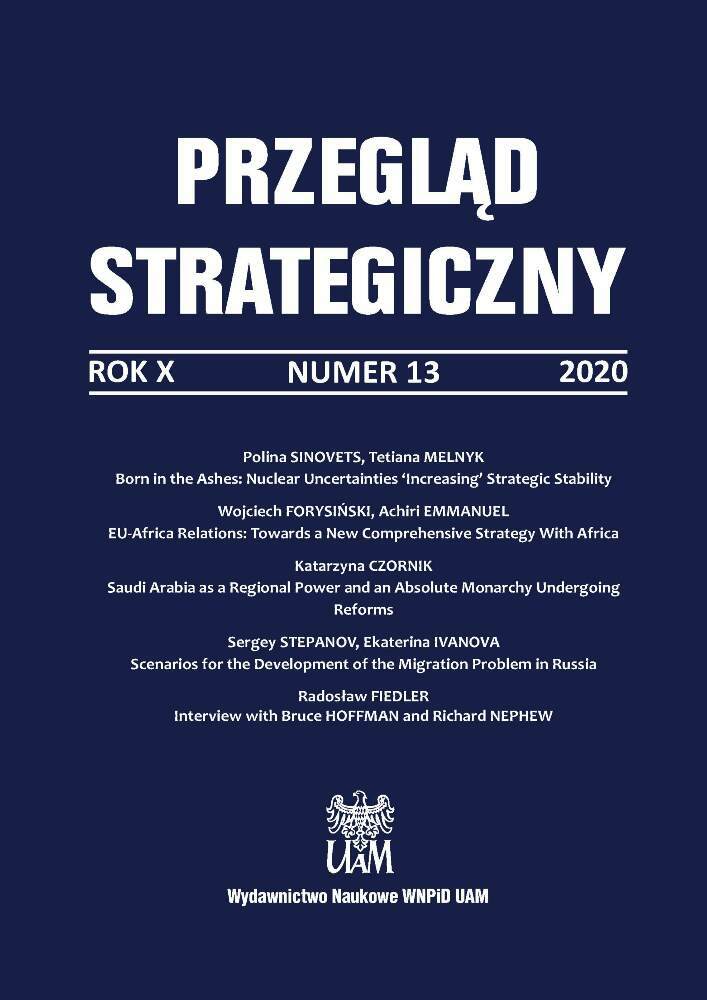Abstract
In the article, the authors analyze the formation of the political identity of citizens of Ukraine as a security factor of Ukrainian statehood. It is noted that, in addition to political identity, there are many other identities, that are presented in the form of a matrix, the components of which continuously interact with, complement and influence each other. In terms of methodology, the process of forming political identity is considered from the standpoint of symbolic interactionism, where the emphasis is placed on political interaction. In addition, in order to objectively assess the effectiveness of the formation of political identity and potential negative consequences in the form of a crisis of statehood, the mechanism for transforming a situational identity into a basic political identity is considered from the standpoint of post-structuralism. The study identifies and formulates criteria for constructing this basic type of political identity, the prerequisites for their formation and correlation with the actual political situation in Ukraine. The multitude of approaches to the study of the formation of political identity is complemented by the consideration of various models of its construction. Fragmental, elite and organic models are considered. Particular attention is paid to the leading role of the state in the process of forming political identity, where the key participants are political elites, the media and civil society. To determine how the perception of the degree of influence of each participant affects the process of political identity formation by the population of Ukraine at different periods of time, with its intermittent outbursts of social activity, the method of factor analysis is used. On the basis of the results of the analysis of the constructed triangular diagrams, two patterns are extracted. According to one, an increase in positive perception and integration into the process of socialization of models of the political identity formation proposed by the political elite is observed in society after each surge in mass protests that leads to a regime change. The other pattern is manifested in the revealed tendentiousness of the influence of the media and political elites on the security level of Ukrainian statehood and the growth of tension in society.
References
About the decision of the National Security and Defense Council of Ukraine on May 6, 2015 “On the National Security Strategy of Ukraine”, https://zakon5.rada.gov.ua/laws/show/287/2015 (15.07.2020).
Abramowitz A. I., Saunders K. L. (2006), Exploring the Basis of Partisanship in the American Electorate: Social Identity vs. Ideology, “Political Research Quartely”, Vol. 59, No. 2.
Ayvazyan G. A. (2010), Political identity as an analytical tool of political science, “Society and power”, No. 3.
Baudrillard J. (1983), In the Shadow of the Silent Majority – Or the End of the Social, Semiotext(e), New York, NY.
Ben-Bassat A., Dahan M. (2012), Social Identity and Voting Behavior, “Public Choice”, Vol. 151.
Blais A., Gidengil E., Nadeau R., Nevitte N. (2001), Measuring Party Identification: Britain, Canada, and the United States, “Political Behavior”, Vol. 23, No. 1.
Blumer H. (1962), Society as symbolic interaction, in: Human Behavior and Social Processes, (ed.) A. Rose, Houghton Mifflin Co, Boston.
Deleuze G. (1992), Postscript on the societies of control, “October”, Vol. 59.
Devine C. J. (2011), Ideological Social Identity: How Psychological Attachment to Ideological Groups Shapes Political Attitudes and Behaviors, The Ohio State University, Columbus.
Erikson E. H. (1968), Identity: youth and crisis, W.W. Norton, New York, NY.
Fowler J. H, Kam C. D. (2007), Beyond the Self: Social Identity. Altruism, and Political Participation, “The Journal of Politics”, Vol. 69, No. 3.
Garry J. (2007), Making «Party Identification» More Versatile: Operationalising the concept for the multiparty setting, “Electoral Studies”, Vol. 26, No. 2, DOI: 10.1016/j.electstud.2006.07.003.
Hall S. (1996), Introduction. Who Needs «Identity»?, in: Questions of cultural identity, (eds.) S. Hall, P. Du Gay, Sage, London.
Hogg M. A., Reid S. A. (2006), Social Identity, Self-Categorization, and the Communication of Group Norms, “Communication Theory”, No. 16.
Huddy L. (2013), From group identity to political cohesion and commitment, in: The Oxford handbook of political psychology, (eds.) L. Huddy, D. O. Sears, J. S. Levy, Oxford University Press.
Inaç H., Ünal F. (2013), The construction of national identity in modern times: Theoretical perspective, “International journal of humanities and social science”, Vol. 3, No. 11.
Klar S. (2013), The Influence of Competing Identity Primes on Political Preferences, “The Journal of Politics”, Vol. 75.
Lapkin V. V., Pantin V. I. (2014), The crisis of Ukrainian statehood: political and legal, value and geoeconomic aspects, “Polis. Political Studies”, No. 5, DOI: 10.17976/jpps/2014.05.00.
McCrone D., McPherson G. (eds.) (2009), National Days. Constructing and Mobilising National Identity, Palgrave Macmillan, London.
Nations in Transit 2009, (Alldata – Nations in Transit, 2000–2009), http://web.archive.org/web/20131208063353/http://www.freedomhouse.org/report/nations-transit/2009/ukraine (24.07.2020).
Nations in Transit 2020, (Alldata – Nations in Transit, 2005–2020 – EXCEL – old scale), https://freedomhouse.org/report/nations-transit (24.07.2020).
Nisnevich Yu. A. (2014), World development indices, (eds.) Yu. A. Nisnevich, O. T. Gasparyan, R. U. Kamalova, E. A. Kocheshkova, Higher School of Economics, Moscow.
Semenenko I. S. (2015), Evolutionary cycles and problems of forecasting political changes, “Polis. Political Studies”, No. 1, DOI: 10.17976/jpps/2015.01.15.
Semenenko I. S., Lapkin V. V., Pantin V. I. (2010), Identity in the system of coordinates of the world development, “Polis. Political Studies”, No. 3.
Shershenev L. I. (1994), Safety: state and public foundations, “Safety”, No. 4(20).
Sobolewska M. (2005), Ethnicity as a Political Clevage: Social Basis of Party Identity and Relevance of Political Attitudes, “Working paper Series”, No. 107.
Taylor C. (1985), Philosophy and the Human Sciences, Cambridge University Press.
Wainer H. (1995), Visual revelations, “Chance”, No. 8.

